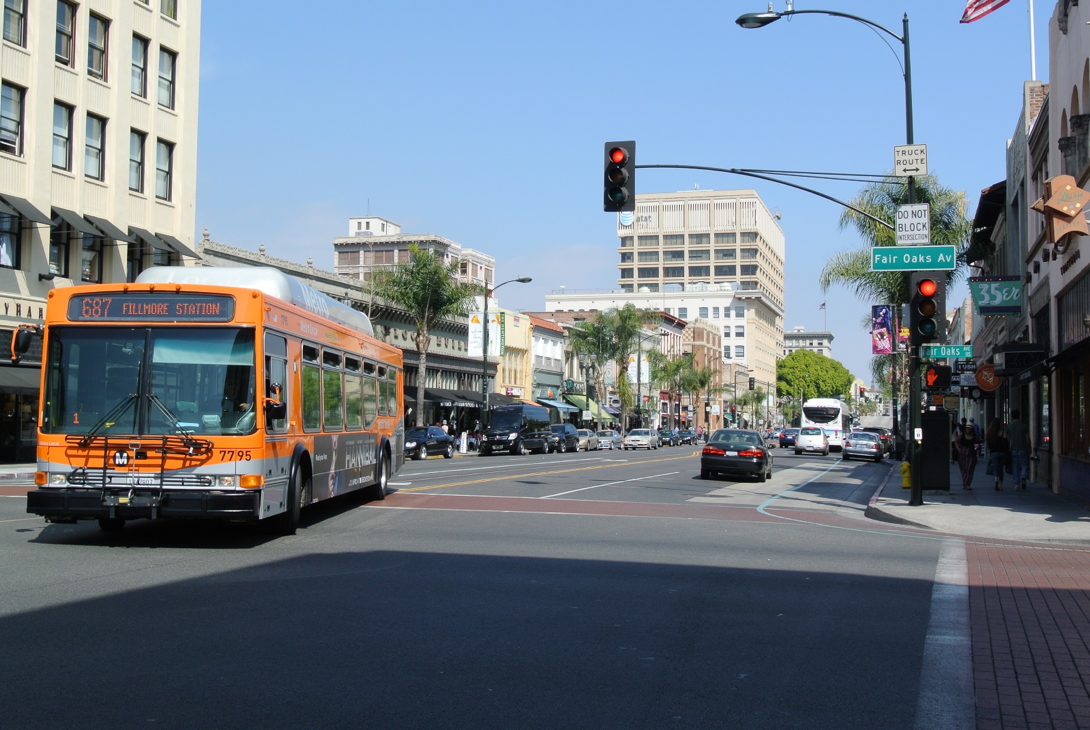News | METRANS Releases New Research on the Impact of Traffic Light Priority for Trucks on Traffic Flow
Stop the VideoNews

METRANS UTC
METRANS Releases New Research on the Impact of Traffic Light Priority for Trucks on Traffic Flow
Saturday, January 21, 2017
by By Shichun Hu, USC MSCE 2017
Currently, traffic light control systems treat all vehicles equally. However, due to different dynamics, trucks behave differently from passenger vehicles: it takes them a longer distance to stop, they have slower acceleration rates, etc. Normally, we don’t pay much attention to these differences, but they can create delays at intersections and affect the travel time of all vehicles involved. To address this issue, METRANS researcher professor Petros Ioannou conducted research titled “Design and Evaluation of Impact of Traffic Light Priority for Trucks on Traffic Flow.”
In his research, Professor Ioannou proposed and evaluated two types of controllers to reduce vehicle delays at traffic lights. The first type, Controller 1, uses a neural network-based model to distinguish between different classes of vehicles and then apply optimization methods. It is also adaptive because it updates once new data is obtained from the infrastructure. The second type, Controller 2, combines passive and active strategies and “gives priority to trucks in certain situations if such an action benefits the overall system.”


Source: https://commons.wikimedia.org/wiki/File:Old_Town_Pasadena_and_Metro_Loca...
After designing the 2 controllers and then employing a microscopic simulation of an actual road network, Professor Ioannou and his team concluded that both controllers improve the network performance indicators such as vehicle delay time, vehicle stops and environmental impact. They made additional comparisons between the 2 controllers when the truck ratio is 3%, 10% and 20% of the overall flow respectively. The three main differences between the two controllers are:
1) The first neural network based controller (controller 1) “works on the intersection level to make decisions,” while the second one (controller 2) “works on both the network and intersection levels.”
2) Controller 1 has less time complexity problem when the road network is scaled.
3) Controller 1 performs better than controller 2 under scenarios where traffic flows are oversaturated.
We encourage you to read the full report here.
Professor Petros Ioannou
Petros A. Ioannou received the B.Sc. degree with First Class Honors from University College, London, England, in 1978 and the M.S. and Ph.D. degrees from the University of Illinois, Urbana, Illinois, in 1980 and 1982, respectively. During the period 1975-1978, he held a Commonwealth Scholarship from the Association of Commonwealth Universities, London, England. He was awarded several prizes, including the Goldsmid Prize and the A. P. Head Prize from University College, London. From 1979 to 1982 he was a research assistant at the Coordinated Science Laboratory at the University of Illinois. In 1982, Dr. Ioannou joined the Department of Electrical Engineering-Systems, University of Southern California, Los Angeles, California. He is currently a Professor in the same Department and the Director of the Center of Advanced Transportation Technologies. His research interests are in the areas of control and applications, adaptive and nonlinear systems, vehicle dynamics and control, intelligent transportation systems, marine transportation, congestion control of computer networks and neural networks.
Read more at http://ee.usc.edu/faculty_staff/faculty_directory/ioannou.htm
Shichun Hu
Author Shichun Hu is a student assistant at METRANS Transportation Center specializing in the METRANS Mentor Program. She is a 2nd year graduate student majoring in Industrial and System Engineering in the Viterbi School of Engineering, USC. Her interests are using data and operation research methods to improve urban logistics and the supply chain. She is pursuing analytical internships in these fields.
News Archive
- December (1)
- November (6)
- October (4)
- September (2)
- August (3)
- July (4)
- June (3)
- May (7)
- April (8)
- March (11)
- February (8)
- January (7)
- December (7)
- November (8)
- October (11)
- September (11)
- August (4)
- July (10)
- June (9)
- May (2)
- April (12)
- March (8)
- February (7)
- January (11)
- December (11)
- November (5)
- October (16)
- September (7)
- August (5)
- July (13)
- June (5)
- May (5)
- April (7)
- March (5)
- February (3)
- January (4)
- December (4)
- November (5)
- October (5)
- September (4)
- August (4)
- July (6)
- June (8)
- May (4)
- April (6)
- March (6)
- February (7)
- January (7)
- December (8)
- November (8)
- October (8)
- September (15)
- August (5)
- July (6)
- June (7)
- May (5)
- April (8)
- March (7)
- February (10)
- January (12)















